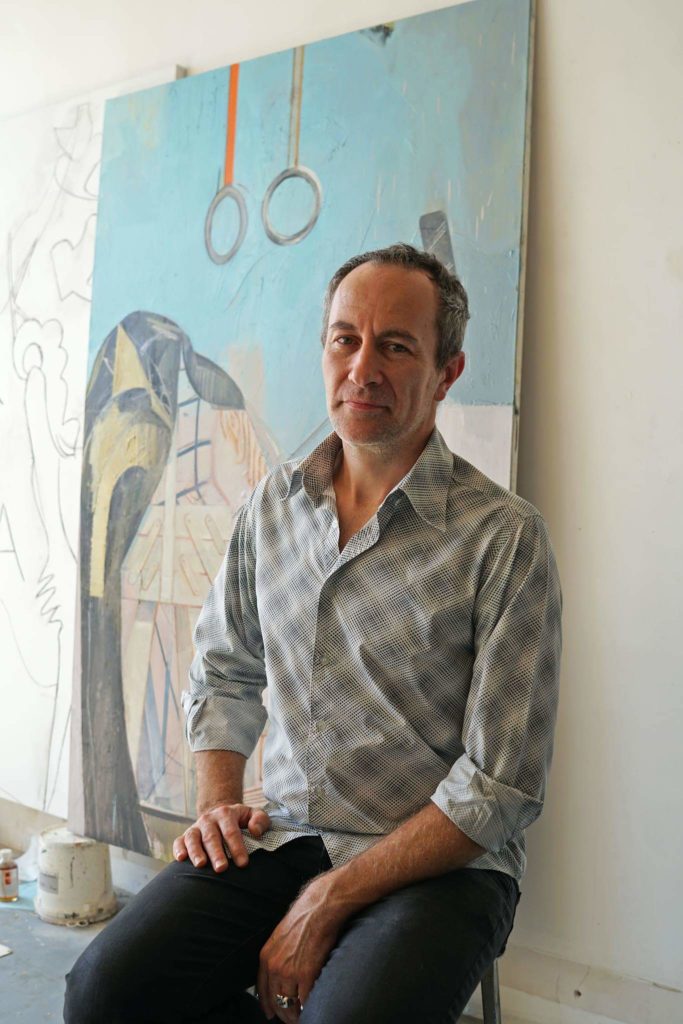In this exhibition, you present artworks of different natures (paintings, sculptures, drawings, etc.); thus working with diverse media. Do you have a favourite medium in your artistic practice? Did those techniques emerge in your practice in a chronological way?
Painting is the spine of my practice. It is with this technique that I learnt how to think. Drawing was also there, since always, but as an autonomous practice it is rarer for me to use it. Volume work is a more recent experience, since 4 or 5 years. The interest of it for me is that it does not bring about the same issues, the same seriousness. The playful, amateur and improvised aspects of three-dimensional sculpture fully nourish my current painting work and reduce the constraints.
Therefore there is a form of chronology with sculpture coming afterwards, but what is important are really the complementarities operating between those different techniques. The intention in drawing is very different from the one of painting or sculpture; however they do thrive together and thanks to each other.
Your different workshops played a leading role in the evolution of your practice. Do all the artworks you chose to exhibit here come from the workshop you currently use?
No, not at all. The works showed at the gallery were produced in three different locations: the sculptures were made in Bayonne, at the school I teach. I created the drawings and the big painting at home in Paris, when I had my workshop in the basement. The other formats were painted in my new space in Montrouge, a suburb of Paris.
You created this exhibition specifically for the space of this gallery, and a twofold presentation was chosen to exhibit your work, with a new instalment on the 21st of November. Was it a personal choice?
I submitted a set of artworks that formed a story about the fantasy surrounding holidays. The number of pieces I presented conditioned M. Belis’ suggestion [the gallerist, editor’s note] for this twofold presentation. I accepted this idea because we could not possibly show all the pieces at once. I sent a modelling of the space of the gallery with a suggestion for the installation of each artwork, that the gallerist perfectly respected.
This exhibition makes us live moments of dream-like floating, however the title you gave it (and especially “ordinary moments”) seems more down to earth and realist. How and why did you choose this title?
I like this sentence from Gilles Deleuze: “Ah, la misère de l’imaginaire et du symbolique, le réel étant toujours remis à demain.” [Oh, the poverty of imagination and symbolism, reality always being postponed, editor’s note].
My paintings try to talk about reality. I try to translate –with the most accuracy possible- a specific time, the time preceding action or outside of the action. What is necessary for holidays? Why is this girl in the distance with a cigarette? My descriptions are floating, weightless, because they are freed from action but they do look for a sort of objectivity.
How did you discover the oil-transfer technique used by Paul Klee? What made you want to use it for your series “Homologie et métaflore”?
I was looking for a form of reduction in my drawings. An idea of the line for itself. I was very interested by the illustrations that the English neoclassicist John Flaxman made for the Divine Comedy. But at the same time my search for radicalism inhibited me.
I worked during several years with a gallery in Bern, Switzerland, and when I went there I couldn’t not pay a visit to the Paul Klee Center. This was where I acquired the certitude that Paul Klee had the same distorted relationship to drawing as I do. Therefore it felt natural for me to steal his technique in order to solve my problem. I do not look for a specific effect when using it. I use this method to circumvent a problem: by blindly transferring my drawing onto a page, I am obligated to focus on what is essential. That way, I dodge any temptation to add more details to make the drawing prettier. Lines are what is strictly necessary to express something, and when the transferring paper is taken out, the drawing is finished.
You make us travel in a very colourful, sometimes child-like universe that is extremely touching. Sometimes, an underlying drawing is visible on your paintings, a drawing totally different from what you painted over. Do you rework your paintings? Or do you re-use your canvases?
Unlike the images of our overly-connected world today, painting is not immediate. According to me, the very nature of painting is time. A painted image is really a pile of temporal layers. Matisse was an archeologist painter who literally dug into his paintings in order to make old layers resurface. For example, it is very visible in a painting such as Interior with a Goldfish Bowl. For me, things sometimes stabilize themselves very late and the wanderings of the beginning are fully part of history, of the canvas material. I like to let them perspire, to not cover them up, to accept the game of digressions. I also sometimes re-work and cover up old paintings, but there aren’t any of those in this exhibition.
Interviewed by Julie Hoedts
Exhibition : Ricochets et moments ordinaires, Guyenne Art Gascogne Gallery










